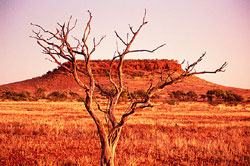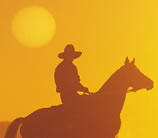OUTBACK HISTORY
 Never-say-die Lasseter
Never-say-die Lasseter
In a new twist to the indomitable Lasseter legend, Vietnam veteran Bill Decarli claims to have found the elusive reef of gold by reversing Lasseter’s map.
Story Angie Testa Photos Bill Decarli
Ever since the death of Harold Lasseter in February 1931 in the inhospitable,
scorching Western Australian desert, prospectors and fortune-hunters have
tried in vain to find the gold reef he claimed was there. As recently as
January 2003, a party, which included Lasseter’s son Bob, his sister Joy
McClure, her son Alan (himself a prospector), along with a team of professionals
journeyed to the place on Irving Creek, west of Alice Springs, where Lasseter
had perished. In a moving ceremony, Joy McLure read from her father’s Bible
on the spot where Bob Lasseter had previously erected a cairn to his father’s
memory. Members of the party also looked for the famous reef and crucial
landmarks mentioned in Lasseter’s diary, which are situated on land sacred
to the local Aboriginal people. No reef was found, and the general consensus
put forward was that visibility of the landmarks might be dependent on atmospheric
conditions, such as a morning haze.
Yet, when the tough, down-to-earth Lasseter approached the president of the
Australian Workers’ Union in Pitt Street, Sydney, in 1929 with his story
of a fabulous gold reef several feet high and many miles long, he was quite
specific about the landmarks in relation to the reef. He had them jotted
down in his diary. They consisted of three hills to the north-west of the
reef, which resembled ladies talking together wearing “sun bonnets”, a waterhole
adjacent to the reef and a hill to the south-east of the reef. He had written
about bearings taken “from a very high hill nearby”, adding that there was
a small lake 20 miles west of the reef. ![]()
Full story OUTBACK Issue 37 October/November 2004


